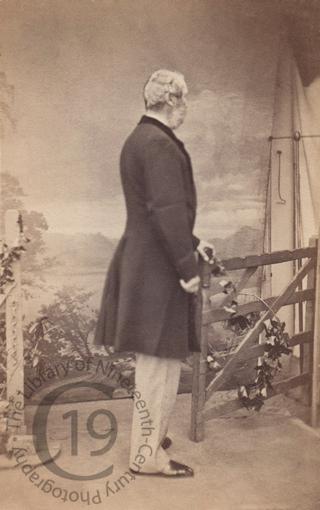
Walter Little Gilmour
A pencilled inscription recto in the lower margin identifies the sitter as 'W.L. Gilmour.'
Born on 24 April 1807, Walter Little Gilmour was the eldest son of Walter Gilmour of Craigmillar. He died without issue on 30 September 1887 at 26 North Bank, Regent's Park, London, leaving an estate valued at £31,896.
A lengthy obituary in the journal Truth detailed his sporting pursuits:
'The death of Mr Walter Little Gilmour has removed a fine sportsman of the old school. Mr Gilmour was the senior member of the Caledonian and Melton Hunts, and, with the exception of his intimate friend, the Duke of Rutland, he was the sole survivor of the group depicted in Sir Francis Grant's celebrated picture, the Melton Breakfast. He commenced to hunt in Leicestershire as soon as he was emancipated from maternal control [...]. He hunted from Melton during the greater part of his life, and he possessed a splendid stud of weight-carrying hunters. [...] His most intimate Melton friends were the late Lord Wilton, the late Lord Eglinton, and Count Matuscewitz. Mr Gilmour was a keen and expert salmon-fisher, and for many years he rented the Rothes water on the Spey. He was also a very fine shot, and during a long succession of years he spent a month every autumn with his close ally, the late Mr Stirling Crawfurd, at Dalnaspidal, in Perthshire, where he always did great execution among the grouse, although his weight and constant gout prevented him from walking over the moors. He invariably rode a well-trained pony, and has often shot forty brace of grouse in a day from the saddle. [...] He was also a notable golf-player, and he was a regular visitor at St Andrew's for many years, going latterly about the Links on a pony. [...] He recently expended a large sum in a judicious restoration of the fine ruins of Craigmillar Castle, once the favourite residence of Queen Mary, and he had lately carried out extensive repairs at the interesting tower at Over Liberton. He was one of the best landlords in Great Britain, and his tenants always found him most liberal and considerate, although he had not resided on his estate for many years; but he always took great interest in its management. He was a stout Conservative, but he was never known to interfere in any way whatsoever, either directly or indirectly, with the political proceedings of his tenants. Mr Gilmour passed the closing years of his life at a small house in St John's Wood, where he received constant visits from his friends. He was buried in the vault of his ancient family in the Greyfriar's burying-ground in Edinburgh [...]. Mr Gilmour's valuable estates in Midlothian pass to his grand-nephew, and he has left a large amount of personal property, as for a considerable period he lived far below his income, and he never was an extravagant man' (Truth, 13 October 1887).
Photographer by James Ross of Edinburgh
Code: 126589




